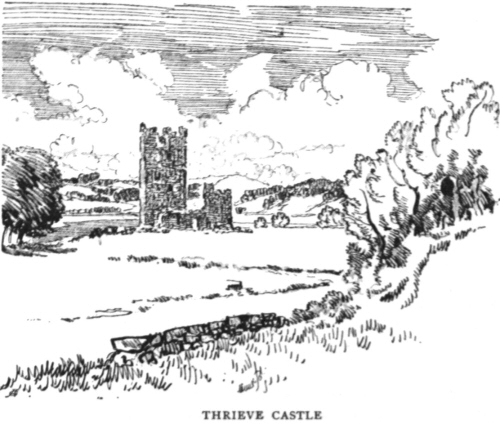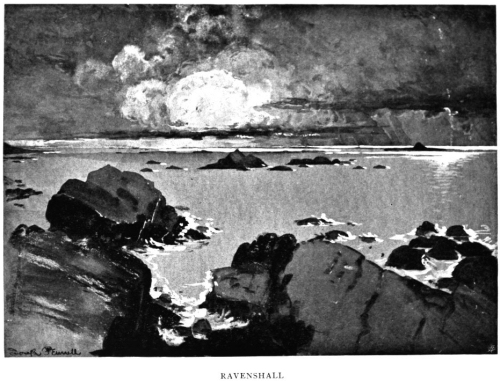|

A GLIMPSE OF BALMAGHIE IN THE
TIMES OF OLD
THRIEVE CASTLE and its island are in Balmaghie, and It is
quite likely that the central position of the parish, as well as the
strength of the situation, may have had something to do with the choice of
the warrior lords of Douglas, when they built them their “head-house and
principal stronghold of the Thrave."
At any rate no parish was so immediately under their stern
eye as Balmaghie. It was in a manner their home-farm, and the marshy nature
of the ground on the Kelton side makes the tradition exceedingly probable
that the great Douglas tournaments took place on the braes of Balmaghie,
somewhere between the fords of Glenlochar and the green hill called
Knockcannon, on which in after-times Mons Meg was placed for the battering
down of the last strength of the Douglases.
Thus were the lists closed for the tourney in the times of
old.
“By ten of the clock the braes of Balmaghie were a sight
most glorious to look upon. Well-nigh twelve thousand men were gathered
there, of whom five thousand were well-mounted knights and fully-equipped
men-at-arms, every man of them ready and willing to couch a lance or ride a
charge.
“The line of the tents which had been set up extended from
opposite the castle island of Thrieve to the kirk hill of Balmaghie. Every
knight's following was strictly kept within its own pale, or fence of green
wands set basket-wise, pointed and thrust into the earth like the spring
traps of those who catch moudieworts.
“Each camp displayed the device of its own lord, but higher
than all, from the top of every mound and broomy hillock floated the banner
of the overlord. This was the lion of Galloway, white on a ground of blue,
and beneath it, but on the same staff, a pennon whereon was the Bleeding
Heart of the Douglas family.
“The lists were set up on the level meadow that is now
called the Boat Croft. At either end a pavilion had been erected, and the
jousting-green was strongly fenced in, with a rising tier of seats for the
ladies along one side, and a throne in the midst for the Douglas himself, as
high and as nobly upholstered as if the King of Scots had been presiding in
person.
"At ten by the great sun-dial of Thrieve, the earl, armed
in complete armour of rare Tourainian work, damascened with gold, and
bearing in his hand the truncheon of commander, rode first through the fords
of Lochar, and immediately after him came his brother David, a tall,
handsome boy of fourteen, whose olive skin and dark high-bred beauty
attested his DougIns birth.
“Next rode their cousin, the Earl of Angus, a red,
foxy-featured man, with mean and shifty eyes. He sat his horse

awkwardly, perpetually hunching his shoulders forward as if
he feared to fall over his beast's head. And saving among his own company,
no man did him any honour, which caused him to grin with wicked sidelong
smiles of hate and envy. .
"Then amid the shouting of the people there appeared, on a
milk-white palfrey, Margaret, the earl's only sister, already famous over
all Scotland as ‘The Fair Maid of Galloway.'
The Tournament at Glenlochar.
“Behind these came the whole array of the knights and barons
who owned allegiance to the Douglas–Herons and Maxwells, Ardwell Macullochs,
Gordons from the Glen of Kells, with Agnews and MacDowalls from the
Shireside. But above all, and outnumbering all, there were the lesser chiefs
of the chief's own mighty name–Douglases of the North, the future Moray and
Ormond among them, the noble young sons of James the Gross of Avondale, who
rode nearest their cousin, the head of that clan. Then came Douglases of the
Border, Douglases of the Hermitage, of Renfrew, of Douglasdale. Every third
man in that great company which splashed and caracoled through the fords of
Lochar was a William, a James, or an Archibald Douglas. The king himself
could not in all Scotland have raised such a following, and it is small
wonder if the heart of the young earl expanded within him.
"Presently, soon after the arrival of the cavalcade, the
great wappenshaw was set in array, and forming up company by company the
long double line extended as far as the eye could reach from north to south
along the side of the broad and sluggish-moving river.
" The great muster was at last over. The tents which had
been dotted thickly athwart the castle island were already mostly struck,
and the ground was littered with miscellaneous debris, soon to be carried
off in trail carts with square wooden bodies set on boughs of trees, and
flung into the river by the earl's varlets and stablemen.
“The multitudinous liege men of the Douglas were by this
time streaming homewards along every mountain pass. Over the heather and
through the abounding morasses horse and foot took their way, no longer
marching in military order, as when they came, but each lance taking the
route which appeared the shortest to himself. North, east, and west
spear-heads glinted and armour flashed against the brown of the heather and
the green of the little vales, wherein the horses bent their heads to pull
at the meadow hay as their riders sought the nearest way back again to their
peel-towers and forty-shilling lands.
" But the long files of horsemen threaded their way across
the green plain of the isle towards the open space in front of Thrieve
Castle, the points of their spears shining high in the air, and the shafts
so thick underneath that, seen from a distance, they made a network of
slender lines reticulated against the brightness of the sun.
“The great island strength of the Douglases was then in its
highest state of perfection as a fortress and of dignity as a residence.
Archibald the Grim, who built the keep, could not have foreseen the wondrous
beauty and strength of which Thrieve would attain under his successors. This
night of the wappenshaw the lofty grey walls were hung with gaily-coloured
tapestries draped from the overhanging gallery of wood which ran round the
top of the castle. From the four corners of the roof flew the banners of
four provinces which owned the sway of the mighty house–Galloway, Annandale,
Lanark, and the Marches, while from the centre, on a flagstaff taller than
any, flew their standard royal, for so it might truly be called, the heart
and stars of the Douglases' more than royal house.
“While the outer walls thus blazed with colour, the woods
around gave back the constant reverberation of cannon, as with hand-guns and
artillery of weight the garrison greeted the return of the earl and his
guests. The green castle island was planted from end to end thick with tents
and gay with pavilions of many hues and various design, their walls covered
with intricate devices, and each flying the colours of its owner; while on
poles without dangled shields and harness of various kinds, ready for the
younger squires to polish as their office demanded. Many of these were
already at their work. and as one and another joined the throng they took up
the chorus of the Douglas gathering-song:–
‘Hasten ye, hastenye! Come to the riding,
Hasten ye, hasten ye, lads of the Dee–
Douglasdale come–come Galloway, Annandale–
Galloway blades are the wale o’ the three!’”1
1 “The Black Douglas,” p. 163 (Smith, Elder & Co.)
|
